Topical Anesthetic Selector
Select your preferences and click "Find Best Cream" to get personalized recommendations.
When you need a fast‑acting numbing cream, Prilox Cream is a topical formulation that combines 2.5% lidocaine and 2.5% prilocaine to provide localized anesthesia. Anyone who’s had a tattoo, laser hair removal session, or minor skin procedure knows the terror of waiting for the sting to pass. That’s why comparing Prilox with its rivals matters - you want the quickest onset, longest comfort, and the safest profile without breaking the bank.
Key Takeaways
- Prilox blends lidocaine and prilocaine at 2.5% each, delivering onset in 5‑10 minutes and lasting up to 2 hours.
- EMLA Cream uses the same actives but at higher concentrations (2.5% each), making it prescription‑only in many regions.
- Lower‑cost over‑the‑counter options like LMX4 contain only lidocaine, which means slower onset for deeper procedures.
- Safety hinges on proper dosing; all creams share risks of skin irritation and rare systemic effects.
- Choose based on procedure depth, required duration, and regulatory status in your country.
How Prilox Cream Works
The magic comes from two local anesthetics: lidocaine (an amide‑type anesthetic that blocks voltage‑gated sodium channels) and prilocaine (a partner that adds deeper tissue penetration). When applied, they diffuse through the stratum corneum, temporarily halting nerve signal transmission. The dual‑action formula speeds up onset compared with single‑agent creams while keeping the concentration low enough to stay within OTC safety limits in Australia.
Common Alternatives on the Market
Below are the most frequently encountered topical anesthetics that compete with Prilox. Each entry includes a brief definition and its core attributes.
- EMLA Cream (a prescription‑grade mix of 2.5% lidocaine and 2.5% prilocaine) - widely used in hospitals for venipuncture and minor surgery.
- LMX4 (a 4% lidocaine cream available OTC in the US and EU) - marketed for small skin irritations and superficial procedures.
- Lido Cream (a 5% lidocaine formulation sold in some Asian markets) - offers faster onset but higher irritation potential.
- Dr. Numb (a blend of lidocaine, prilocaine, and sometimes benzocaine, sold as a cosmetic numbing gel) - popular among tattoo artists for its strong numbing effect.
- Xylocaine Cream (5% lidocaine, primarily a prescription product for dental procedures).
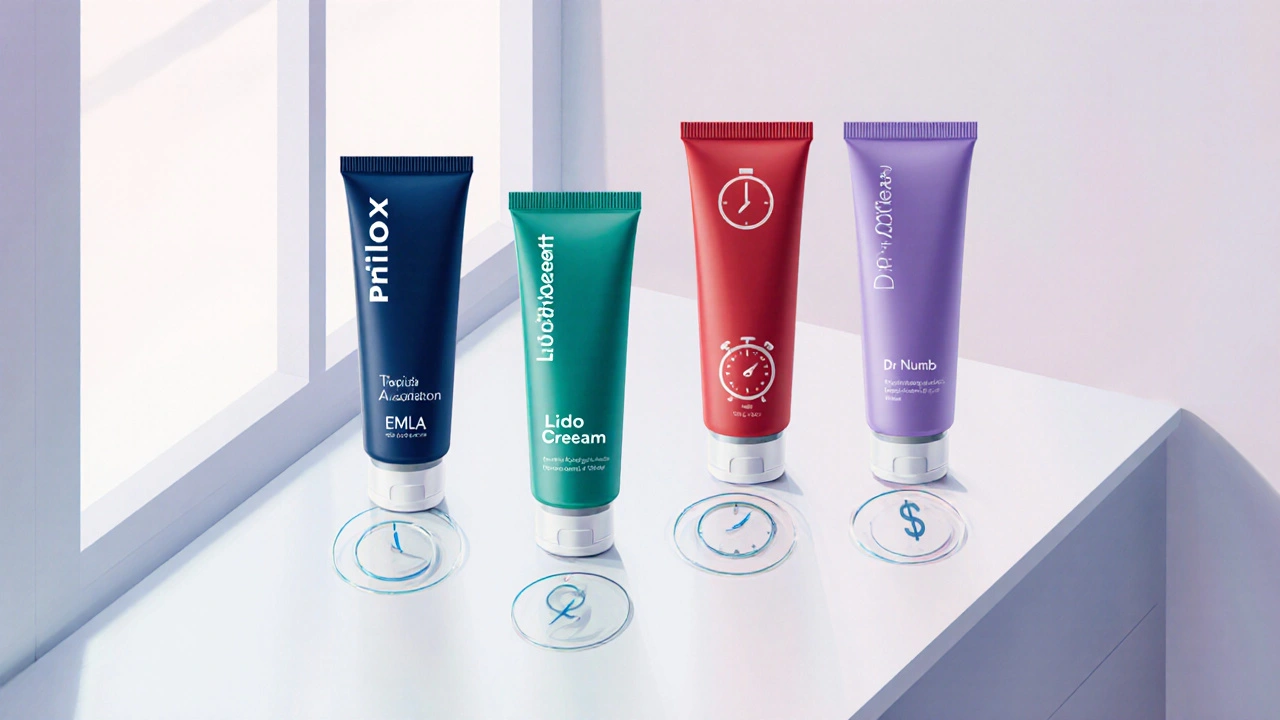
Side‑by‑Side Comparison
| Feature | Prilox Cream | EMLA Cream | LMX4 | Lido Cream | Dr. Numb |
|---|---|---|---|---|---|
| Active ingredients | Lidocaine 2.5% + Prilocaine 2.5% | Lidocaine 2.5% + Prilocaine 2.5% | Lidocaine 4% | Lidocaine 5% | Lidocaine 4% + Prilocaine 2% (+ optional benzocaine) |
| Regulatory status (Australia) | OTC (Pharmacy‑only) | Prescription‑only | OTC | Prescription‑only | OTC (Cosmetic) |
| Onset time | 5‑10min | 10‑20min | 15‑30min | 5‑10min | 5‑15min |
| Peak effect | 30‑45min | 45‑60min | 45‑60min | 30‑45min | 30‑45min |
| Duration | 90‑120min | 120‑180min | 60‑90min | 90‑120min | 90‑150min |
| Typical price (AU$) | 12‑16 (30g tube) | 20‑30 (prescription) | 8‑12 (30g tube) | 15‑22 (30g tube) | 10‑14 (30g tube) |
Pros and Cons of Prilox Cream
Prilox Cream strikes a balance between effectiveness and accessibility. Below are the highlights compared with each rival.
- Advantages
- OTC availability means you can buy it without a doctor’s note.
- Dual‑agent mix gives faster onset than lidocaine‑only products.
- Lower concentration reduces the risk of systemic toxicity.
- Price sits comfortably between cheap lidocaine‑only creams and pricey prescription options.
- Drawbacks
- Not as long‑lasting as EMLA for deep surgical procedures.
- May cause mild skin redness in sensitive individuals.
Safety Profile & Contra‑indications
All topical anesthetics share a core safety principle: they should never be applied to broken skin or large surface areas exceeding 10% of body surface without medical supervision. Specific concerns include:
- Local irritation - itching, erythema, or a burning sensation appears in up to 5% of users.
- Methemoglobinemia - rare but serious; higher with prilocaine doses over 8mg/kg.
- Allergic reactions - watch for hives or swelling, especially if you’ve reacted to amide anesthetics before.
- Pediatric use - recommended only for children over 12 months; dosage must be strictly limited.
- Pregnancy & lactation - classified as Category B in Australia; still advisable to consult a pharmacist.
To stay safe, follow the recommended amount (usually a pea‑sized layer covering the target area) and wait the suggested onset time before proceeding.
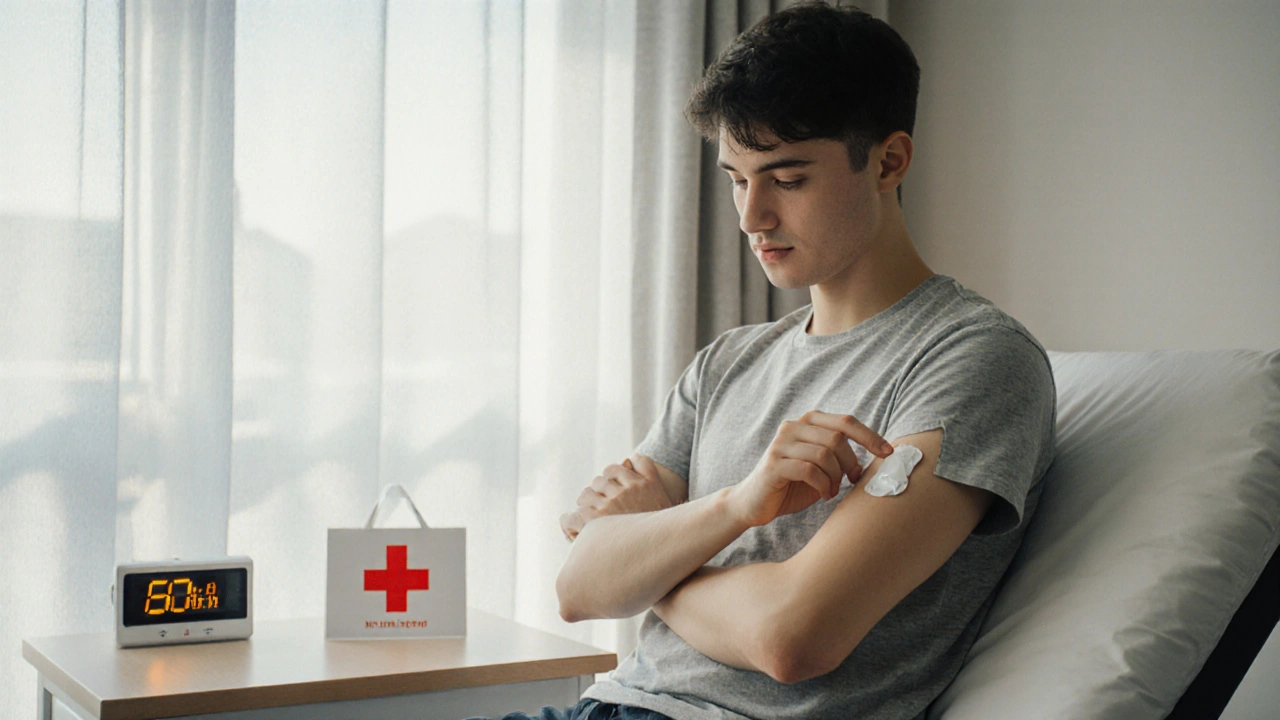
Application Tips for Best Results
- Clean the skin with mild soap and water; pat dry.
- Apply a thin, even film of cream, covering only the intended zone.
- Cover with an occlusive dressing (plastic wrap or a breathable bandage) to enhance absorption.
- Set a timer - 5min for Prilox, longer for lidocaine‑only products.
- Remove the dressing before the procedure; gently wipe any excess cream.
- Perform a 24‑hour patch test if you’re using the product for the first time.
Choosing the Right Cream for Your Need
Think about the depth of the procedure, the duration you need, and your local regulations.
- Shallow skin work (e.g., superficial laser, minor skin tags) - Prilox or LMX4 works well; the quicker onset saves time.
- Medium‑depth procedures (e.g., tattooing, dermabrasion) - EMLA offers a longer window, though you’ll need a prescription.
- Deep or painful interventions (e.g., minor surgical excision) - A higher‑strength cream like Lido or a double‑dose of EMLA under medical supervision is preferable.
- Budget‑tight scenarios - LMX4 provides acceptable numbness at the lowest price point.
In practice, many professionals keep two products on hand: an OTC option for quick jobs (Prilox or LMX4) and a prescription‑strength cream for longer, more invasive work.
Frequently Asked Questions
Can I use Prilox Cream for tattooing?
Yes. Apply a thin layer about 10minutes before the session, cover with a plastic wrap, and remove it right before the needle work begins. Most tattoo artists report a noticeable reduction in pain for the first hour.
Is Prilox Cream safe for children?
It can be used on children older than 12 months, but the amount must not exceed 2mg/kg of each active component. Always perform a small patch test first and avoid covering large body areas.
How does Prilox differ from EMLA?
Both contain lidocaine and prilocaine, but EMLA is generally prescribed at a higher total concentration (2.5% each) and is regulated as a prescription product in Australia. Prilox is sold OTC at the same percentages but in a lower‑volume tube, making it more convenient for occasional use.
What should I do if I experience severe skin irritation?
Immediately wash the area with mild soap and water, discontinue use, and apply a cool compress. If redness persists beyond 24hours or you develop swelling, seek medical advice.
Can I combine Prilox with oral painkillers?
Yes, topical anesthetics act locally and don’t interfere with common oral analgesics such as ibuprofen or paracetamol. However, avoid using multiple topical numbing products at the same time.
Bottom Line
If you need a reliable, easy‑to‑get numbing cream for superficial procedures, Prilox Cream offers a sweet spot of speed, safety, and cost. For longer, deeper work, consider a prescription‑grade alternative like EMLA. Always respect dosing guidelines, run a quick patch test, and store the product out of reach of children.

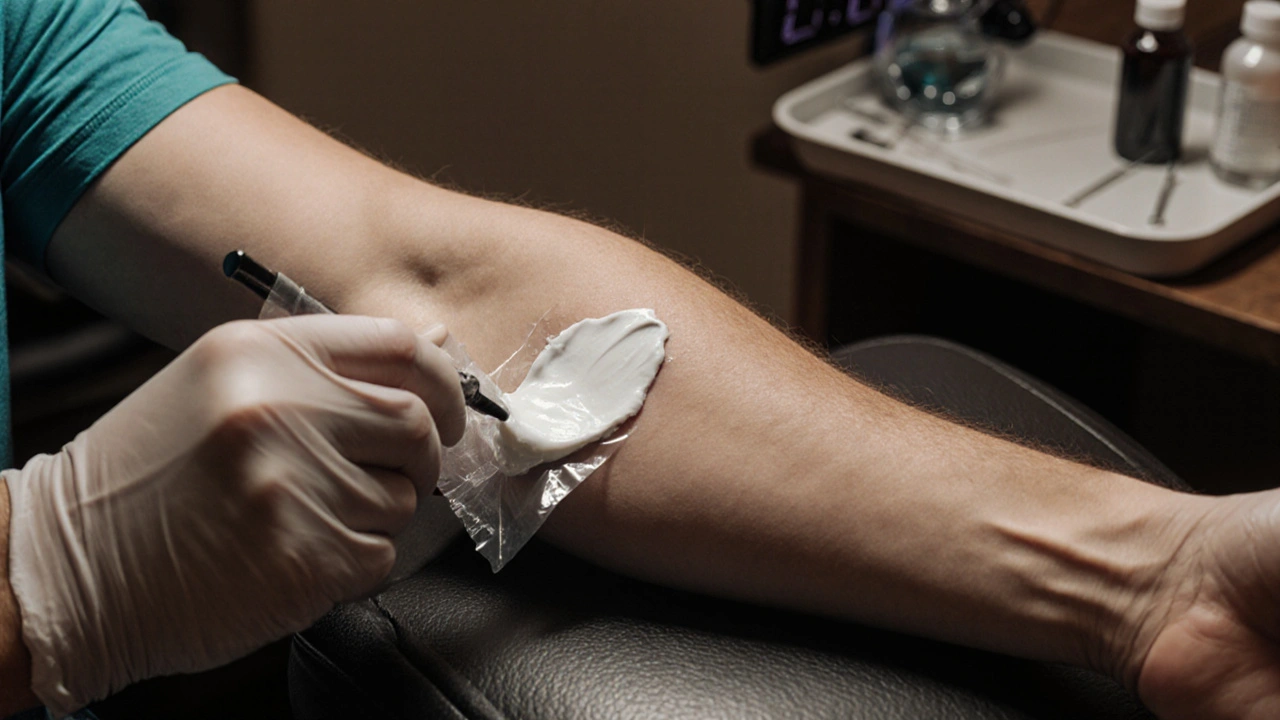



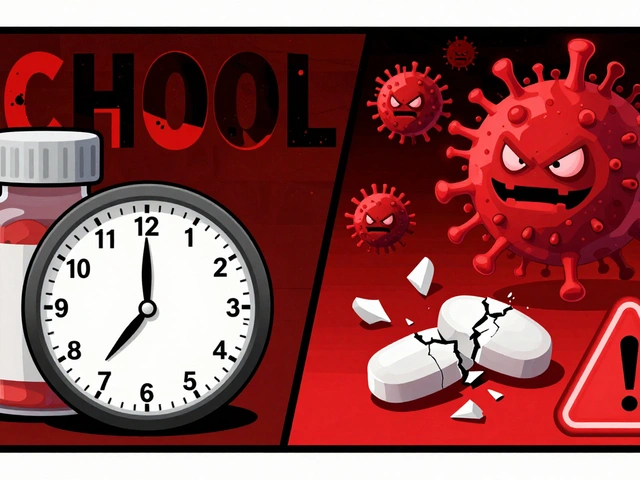
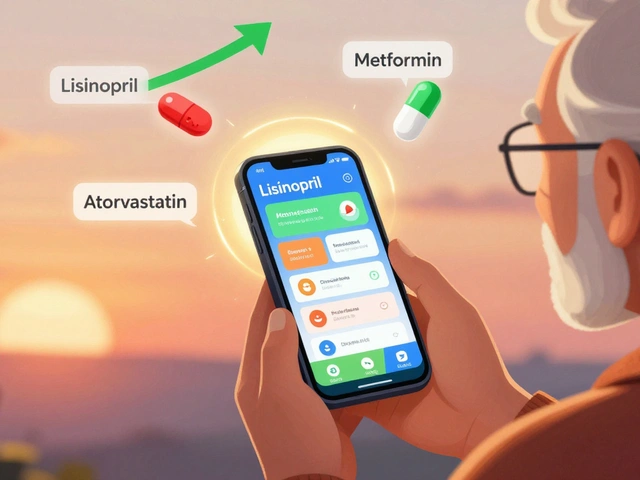
Olivia Crowe
October 6, 2025 AT 13:30Wow, what a game‑changer! Prilox hits the sweet spot between speed and safety, making those quick laser sessions feel like a breeze.
Aayush Shastri
October 7, 2025 AT 00:37In India, we often lean on Prilox for its OTC availability, especially in bustling clinics where time is precious. The dual‑agent mix aligns well with our preference for fast onset without the paperwork of prescriptions. Plus, the price point fits nicely into both urban and rural budgets.
Quinn S.
October 7, 2025 AT 11:44The article erroneously claims that EMLA contains a higher total concentration than Prilox, when in fact both formulations contain 5 % lidocaine‑prilocaine combined. Such inaccuracies undermine credibility and must be rectified promptly.
Dilip Parmanand
October 7, 2025 AT 22:50Let's keep the facts straight, folks-precision matters, especially when users rely on these creams for pain relief.
Sarah Seddon
October 8, 2025 AT 09:57Picture this: you’re about to get a tiny tattoo, heart racing, and you slather on Prilox. Within minutes, the sting fades like a distant echo, and you glide through the session with confidence-pure magic!
Ari Kusumo Wibowo
October 8, 2025 AT 21:04Sure, the vibe’s cool, but don’t forget that for deeper procedures the numbing window might fall short-still worth a double‑dose under professional eyes.
Hannah Gorman
October 9, 2025 AT 08:10When evaluating topical anesthetics, one must adopt a holistic framework that accounts not only for pharmacokinetics but also for regulatory landscapes, patient demographics, and procedural nuances. Prilox, with its balanced 2.5 % lidocaine and 2.5 % prilocaine composition, offers a commendable equilibrium between efficacy and safety, particularly for superficial interventions. Nonetheless, its OTC status, while convenient, may inadvertently lead to overuse or misuse among laypersons lacking medical supervision. Conversely, EMLA’s prescription requirement introduces an additional safeguard, albeit at the expense of accessibility. The lidocaine‑only contenders, such as LMX4, present a cost‑effective alternative but suffer from slower onset and reduced depth penetration. Moreover, clinicians should be vigilant about methemoglobinemia risks inherent to prilocaine, especially in pediatric cohorts. Ultimately, the decision matrix should be individualized, weighing procedural depth, duration, and patient tolerance thresholds.
Dan Burbank
October 9, 2025 AT 19:17The intricate tapestry of topical anesthetic selection is not merely a question of price or convenience, but a reflection of our collective philosophy toward medical autonomy.
In the grand theater of dermal interventions, Prilox assumes the role of the nimble understudy, ready to step into the spotlight at a moment's notice.
Yet, to relegate it to a simplistic cost‑benefit analysis would be an egregious oversimplification of a multifaceted pharmacological narrative.
EMLA, draped in the gravitas of prescription status, embodies the archetype of the seasoned veteran, commanding respect through its prolonged duration and deeper penetration.
Such gravitas, however, is not without its own shackles, for the bureaucratic labyrinth required to obtain it can impede timely care.
LMX4, the humble workhorse, offers a modest entry point for the frugal practitioner, though its modest lidocaine concentration inevitably curtails its anesthetic horizon.
Lido Cream, with its bold 5 % lidocaine surge, flirtates with the boundaries of cutaneous tolerance, inviting both admiration and caution.
The cultural predilections of different regions further complicate this tableau, as regulatory frameworks dictate the accessibility of each formulation.
Australian consumers, for instance, enjoy the relative liberty of acquiring Prilox over the counter, whereas their North American counterparts may grapple with divergent labeling standards.
From an ethical standpoint, the onus lies upon clinicians to educate patients, lest the democratization of these agents devolve into a Pandora's box of adverse events.
Methemoglobinemia, though rare, looms as a specter whenever prilocaine is employed beyond recommended thresholds, demanding vigilant dose monitoring.
Furthermore, the psychosocial aspect of pain perception cannot be dismissed; the mere belief in a potent cream can amplify the placebo effect, enhancing overall comfort.
In practice, a judicious combination of occlusive dressings and precise timing can extract maximal benefit from even modest formulations like Prilox.
Ultimately, the clinician's arsenal should be diversified, stocking both the reliable OTC options and the more potent prescription variants to tailor therapy to each unique scenario.
Thus, the true mastery of topical anesthesia resides not in the singular supremacy of any cream, but in the nuanced choreography of choice, context, and patient‑centered care.
Anna Marie
October 10, 2025 AT 06:24It is imperative to adhere strictly to the recommended application parameters, as deviation can precipitate systemic absorption and unforeseen complications.
Abdulraheem yahya
October 10, 2025 AT 17:30Indeed, the precision you emphasize is vital; however, we must also recognize that real‑world settings often involve patients with varying skin integrity and cultural attitudes toward pain, which can influence both the efficacy and tolerability of the anesthetic. For instance, in many West African communities, the preference for natural remedies may lead individuals to under‑apply topical agents, thereby reducing their intended effect. Moreover, the ambient temperature and humidity can alter dermal absorption rates, sometimes necessitating adjustments in exposure time. Consequently, clinicians should adopt a flexible protocol that accommodates these variables while maintaining safety thresholds.
Preeti Sharma
October 11, 2025 AT 04:37One could argue that the fixation on incremental onset times obscures a deeper truth: pain perception is as much a mental construct as it is a physiological response, and any cream, no matter how swift, merely skims the surface of this complex experience.
Ted G
October 11, 2025 AT 15:44The industry’s push for Prilox’s OTC status may conceal undisclosed data about long‑term side effects kept hidden from the public.
Miriam Bresticker
October 12, 2025 AT 02:50i just tried the Prilox on a tiny laser spot and wowww it worked like magic!! 😎✨ 5 mins and i felt no pain, wtf is next level numbing!!!
Claire Willett
October 12, 2025 AT 13:57Prilox offers rapid onset (5‑10 min), moderate duration (~2 h), OTC status-ideal for low‑risk dermal procedures.
olivia guerrero
October 13, 2025 AT 01:04Absolutely, the data is crystal clear, and it’s wonderful to see such a practical solution, especially for quick appointments, right?
Dominique Jacobs
October 13, 2025 AT 12:10Yo, if you’re looking to level up your numbing game, grab Prilox for those fast gigs, but remember to double‑check the occlusion technique-it's a total game‑changer for maximizing absorption!
Claire Kondash
October 13, 2025 AT 23:17Contemplating the ethics of over‑the‑counter anesthetics reveals a paradox wherein autonomy clashes with responsibility.
When a consumer self‑administers a potent lidocaine‑prilocaine blend, they wield power traditionally reserved for clinicians.
Yet, this empowerment can foster complacency, leading to neglect of proper dosing guidelines.
The resulting skin irritation or, in rare cases, systemic toxicity, serves as a stark reminder of pharmacological limits.
On the other hand, dismissing patient agency undermines trust and hampers the democratization of healthcare.
Balance, therefore, emerges as the guiding principle, demanding both education and regulated access.
In practice, integrating brief tutorials at point‑of‑sale could bridge this gap, ensuring safe use without stifling innovation.
Let’s champion informed choice, because knowledge is the true antidote to risk. 🌟
Matt Tait
October 14, 2025 AT 10:24Honestly, most of these reviews are just marketing fluff; if you need real pain relief, stick to the tried‑and‑true EMLA.